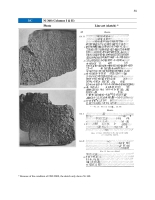Ni 368 (Nippur 00368) is the upper half of a large four-column clay tablet artifact that contains a significant portion of "Inanna's Descent to the Netherworld" in Sumerian cuneiform. The other half is known as CBS 9800, and provides many lines towards the afterlife myth. This tablet was the basis of Samuel N. Kramer's subsequent translations of the myth. This half was cataloged by Stephen H. Langdon and Edward Chiera as part of an archaeological survey in the late 1800s by the University of Pennsylvania. The tablet is located at the Penn Museum in Philadelphia.
This artifact contains lines 3-57 (column I) and 58-84, 89-113 (column II). CBS 9800 contains lines 114-167 (column III), and 168-211 (column IV) of the Sumerian afterlife myth.
Tablet discovery and publication
This clay tablet was first published as plate number 33 by Stephen Langdon in 1914 as part of a work on tablets from the Nippur expeditions in 1893. This same plate contained artifact Ni 2279, a small tablet containing lines 3-23 of "Inanna's Descent."
Before passing away in 1933, Chiera was working on publishing his artifact discoveries at the University of Chicago's Oriental Institute. His work was posthumously published in 1934 in Sumerian Epics and Myths In this publication were the first images of Ni 368 (plate number 50), one important part that connects to CBS 9800. Because Chiera only published sketches of the artifacts, it would take several years before other scholars would translate what they meant.
Importance for "Inanna's Descent"
In 1942, Samuel Kramer published a translation (and collation) of "Inanna's Descent," where the line numbers were carefully mapped out for this artifact. This publication is referred to as PAPS 85 in citations, short for the Proceedings of the American Philosophical Society; however, the journal seems to have gone defunct in 2015.
Kramer also published a revised translation of these artifacts in 1951 (in the Journal of Cuneiform Studies) as part of his many revisions to the myth's decipherment. This 1951 version of "Inanna's Descent" would remain as the main version of the myth until William R. Sladek published a revised translation in 1974.

















